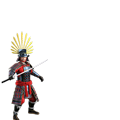Toyotomi Hideyoshi

Toyotomi Hideyoshi: Japan at War
Toyotomi Hideyoshi was the son of a peasant. He became a foot soldier in the army of Oda Nobunaga, the first great Japanese warlord, and fought in a number of important battles, including the Battle of Okehazama in 1560. Hideyoshi’s intelligence was quickly recog nised and he was promoted to samurai and gradually became one of Nobunaga’s most trusted lieutenants. Hideyoshi was appointed a general of the Oda army and led a number of successful campaigns in Western Japan. It was during this time that Hideyoshi learnt of the betrayal of another of Nobunaga’s generals, Akechi Mitsuhide. Mitsuhide was ordered by Nobunaga to send his army to reinforce Hideyoshi. Instead Mitsuhide ordered his army to attack Nobunaga, who was resting at the Honnō-ji temple in Kyoto. Without his army around him and facing certain defeat, Nobunaga and his eldest son both killed themselves by committing seppuku. Hideyoshi immediately moved his army east to avenge Nobunaga and defeated Mitsuhide at the Battle of Yamazaki. However the ques tion of who should succeed Nobunaga as the leader of the Oda clan fueled further conflict. Hideyoshi supported Nobunaga’s grandson whereas Tokugawa Ieyasu, a powerful daimyo (feudal lord), sup ported Nobunaga’s second son. The two armies fought at the Battle of Komaki and Nagakute but no true victor emerged. With their armies severely depleted, Hideyoshi and Ieyasu agreed a truce and eventu ally agreed to form an alliance. In 1586 Hideyoshi was awarded the family name of Toyotomi by Emperor Go-Yōzei, and thus came to bear the name Toyotomi Hideyoshi. Determined to continue Nobun ga’s legacy, Hideyoshi embarked on his attempt to conquer the whole of Japan in an effort to unify the country after more than two centuries of feudal warfare. In 1590 Hideyoshi achieved his goal by sending a massive army to defeat the last of his major rivals, the Hojo clan, at the Siege of Odawara. After their defeat, he forced them to commit suicide and handed their lands to Ieyasu. Following the unification of Japan, Hideyoshi turned his attention to invading Korea. After great initial success, leading to the destruction of large areas of the country, Hideyoshi’s forces were eventually driven back when Korea requested military intervention from China. Hideyoshi died in 1598, still frustrated by his failed campaigns during the Korea war.






























